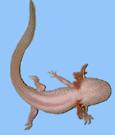Axolotl Strains
Axolotls in the AGSC are typically characterized generally by strain and, more specifically, by the mutant genes which they express or carry.
Categories commonly used by the AGSC
Strains
The AGSC uses several conventions to describe groups of animals in the colony. Each animal has a strain designation based upon the source from which it or its ancestors came. For instance, Wistar animals came from the Wistar Institute and Tompkins animals were imported by Robert Tompkins in 1968. (More information about some of these strains can be found in an article published by Rufus_Humphrey in Axolotl Newsletter Number 1.) Because of extensive cross breeding over the years, most animals in the colony derive from several of these strains.
More informal designations are also used, based upon phenotypes and genotypes (white strain, albino strain, cardiac strain, etc). We are gradually working on "purifying" these strains through breeding and selection so that we can more easily supply animals that , for instance, are white, but not melanoid, or carry cardiac, but not pinhead (see Axolotl Mutants).
Designations commonly used for embryos in the Axolotl Colony
NORMAL
- Embryos: Any pigment mutant may segregate. Lethal recessives are not expected to segregate. Embryo phenotype is usually dark or white.
- Larvae, Juveniles, Adults: Any pigment phenotype is possible.
WILDTYPE
- Phenotype of all embryos is dark, non-melanoid, non-albino, and non-axanthic. Lethal recessives are not expected to segregate. Phenotype of larvae, juveniles, and adults is dark, non-melanoid, non-albino, and non-axanthic.
 Click on this button to see a wild-type axolotl (30 K). Wild-type axolotls are very dark with yellowish or greenish mottling.
Click on this button to see a wild-type axolotl (30 K). Wild-type axolotls are very dark with yellowish or greenish mottling.
WHITE
- Phenotype is white (d/d). May be melanoid unless non-melanoid are requested. Lethal recessives are not expected to segregate. Occasionally previously unidentified Short Toes (s/s) may be found. Many whites also carry the eyeless (e) mutation
 Click on this button to see a white axolotl (11 K). White axolotls have black eyes and pinkish skin.
Click on this button to see a white axolotl (11 K). White axolotls have black eyes and pinkish skin.
ALBINO
-
Phenotype is albino (a/a). Many of our albinos are also axanthic (ax/ax) or carry the gene. Sometimes albinos also carry the cardiac (c) mutation. Albino embryos are the only ones that we do not routinely sort because of the difficulty of working with pigmentless eggs. Order larger numbers to compensate for those which are infertile or non-viable.
 Click on this button to see an albino axolotl (17 K). This golden albino has the genotype D/- a/a. Because the wild-type axolotl has both black and yellow pigments, the dark axolotl without black pigments (the albino) is yellow-colored.
Click on this button to see an albino axolotl (17 K). This golden albino has the genotype D/- a/a. Because the wild-type axolotl has both black and yellow pigments, the dark axolotl without black pigments (the albino) is yellow-colored. Click on this button to see an albino axanthic axolotl (25 K). This axolotl has the genotype D/ a/a ax/ax. When very young axolotls of this genotype are virtually colorless, but as they grow they accumulate riboflavins from their diet, giving them a paler yellow color than is exhibited by the golden albinos.
Click on this button to see an albino axanthic axolotl (25 K). This axolotl has the genotype D/ a/a ax/ax. When very young axolotls of this genotype are virtually colorless, but as they grow they accumulate riboflavins from their diet, giving them a paler yellow color than is exhibited by the golden albinos. Click on this button to see a white albino axolotl (32 K). The white albino axolotl's genotype is d/d a/a. It is similar to appearance to any white axolotl, but the eyes are pinkish rather than black.
Click on this button to see a white albino axolotl (32 K). The white albino axolotl's genotype is d/d a/a. It is similar to appearance to any white axolotl, but the eyes are pinkish rather than black.

